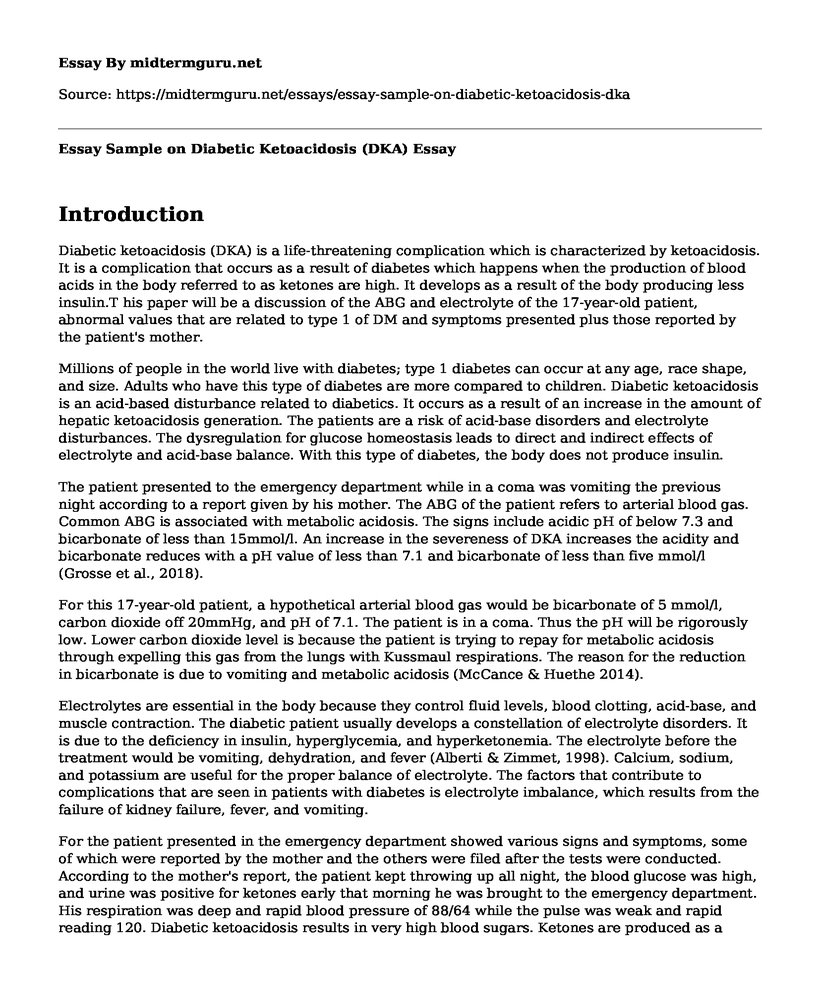Introduction
Diabetic ketoacidosis (DKA) is a life-threatening complication which is characterized by ketoacidosis. It is a complication that occurs as a result of diabetes which happens when the production of blood acids in the body referred to as ketones are high. It develops as a result of the body producing less insulin.T his paper will be a discussion of the ABG and electrolyte of the 17-year-old patient, abnormal values that are related to type 1 of DM and symptoms presented plus those reported by the patient's mother.
Millions of people in the world live with diabetes; type 1 diabetes can occur at any age, race shape, and size. Adults who have this type of diabetes are more compared to children. Diabetic ketoacidosis is an acid-based disturbance related to diabetics. It occurs as a result of an increase in the amount of hepatic ketoacidosis generation. The patients are a risk of acid-base disorders and electrolyte disturbances. The dysregulation for glucose homeostasis leads to direct and indirect effects of electrolyte and acid-base balance. With this type of diabetes, the body does not produce insulin.
The patient presented to the emergency department while in a coma was vomiting the previous night according to a report given by his mother. The ABG of the patient refers to arterial blood gas. Common ABG is associated with metabolic acidosis. The signs include acidic pH of below 7.3 and bicarbonate of less than 15mmol/l. An increase in the severeness of DKA increases the acidity and bicarbonate reduces with a pH value of less than 7.1 and bicarbonate of less than five mmol/l (Grosse et al., 2018).
For this 17-year-old patient, a hypothetical arterial blood gas would be bicarbonate of 5 mmol/l, carbon dioxide off 20mmHg, and pH of 7.1. The patient is in a coma. Thus the pH will be rigorously low. Lower carbon dioxide level is because the patient is trying to repay for metabolic acidosis through expelling this gas from the lungs with Kussmaul respirations. The reason for the reduction in bicarbonate is due to vomiting and metabolic acidosis (McCance & Huethe 2014).
Electrolytes are essential in the body because they control fluid levels, blood clotting, acid-base, and muscle contraction. The diabetic patient usually develops a constellation of electrolyte disorders. It is due to the deficiency in insulin, hyperglycemia, and hyperketonemia. The electrolyte before the treatment would be vomiting, dehydration, and fever (Alberti & Zimmet, 1998). Calcium, sodium, and potassium are useful for the proper balance of electrolyte. The factors that contribute to complications that are seen in patients with diabetes is electrolyte imbalance, which results from the failure of kidney failure, fever, and vomiting.
For the patient presented in the emergency department showed various signs and symptoms, some of which were reported by the mother and the others were filed after the tests were conducted. According to the mother's report, the patient kept throwing up all night, the blood glucose was high, and urine was positive for ketones early that morning he was brought to the emergency department. His respiration was deep and rapid blood pressure of 88/64 while the pulse was weak and rapid reading 120. Diabetic ketoacidosis results in very high blood sugars. Ketones are produced as a waste product when the body breaks fat into sugar.
Tests were carried out on the patient, and the warning signs and symptoms of diabetic ketoacidosis include nausea and vomiting, shortness of breath, frequent urination, and excessive thirst. The complications that are related to diabetic ketoacidosis include kidney failure, cardiac arrest, hypoglycemia, and Cerebral Edema.
The test conducted on the urine was undertaken to evaluate severe hyperglycemia, also looking for the presence of protein in the urine. The result showed that there were ketones. Ketones are proof of the existence of type 1 of DM. Urine test was conducted for testing their ketones because the patient was vomiting and had nausea hence had been throwing up the whole night before he was taken to the emergency department.
References
Grosse, J., Hornstein, H., Manuwald, U., Kugler, J., Glauche, I., & Rothe, U. (2018). Incidence of diabetic ketoacidosis of new-onset type 1 diabetes in children and adolescents in different countries correlates with human development index (HDI): An updated systematic review, meta-analysis, and meta-regression. Hormone and Metabolic Research, 50(03), 209-222.Retrieved from https://www.thieme-connect.com/products/ejournals/pdf/10.1055/a-0584-6211.pdf
McCance, K. L., & Huethe, S. E. (2014). Pathophysiology: The biologic basis for disease in adults and children (7th Ed.). Mosby. Retrieved from http://125.212.201.8:6008/handle/DHKTYTHD_123/1309
Alberti, K. G. M. M., & Zimmet, P. Z. (1998). Definition, diagnosis, and classification of diabetes mellitus and its complications. Part 1: diagnosis and classification of diabetes mellitus. Provisional report of a WHO consultation. Diabetic Medicine, 15(7), 539-553.Retrieved from https://onlinelibrary.wiley.com/doi/abs/10.1002/ (SICI) 1096-9136(199807)15:7%3C539:: AID-DIA668%3E3.0.CO;2-S
Cite this page
Essay Sample on Diabetic Ketoacidosis (DKA). (2023, Jan 28). Retrieved from https://midtermguru.com/essays/essay-sample-on-diabetic-ketoacidosis-dka
If you are the original author of this essay and no longer wish to have it published on the midtermguru.com website, please click below to request its removal:
- Essay on New Drug for the Treatment of Lewy Body Dementia
- The End of June: Reaction Paper
- Explanatory Synthesis on Sleep Deprivation
- FDA AERS: Outcome of Adverse Event Reports - Essay Sample
- Empowering Teen Cancer Patients: Foundation's Awareness Plan - Essay Sample
- Breastfeeding: Essential for Baby's Growth & Well-Being - Essay Sample
- Genetic Improvement for Disease Resistance in Salmonid Species - Annotated Bibliography







